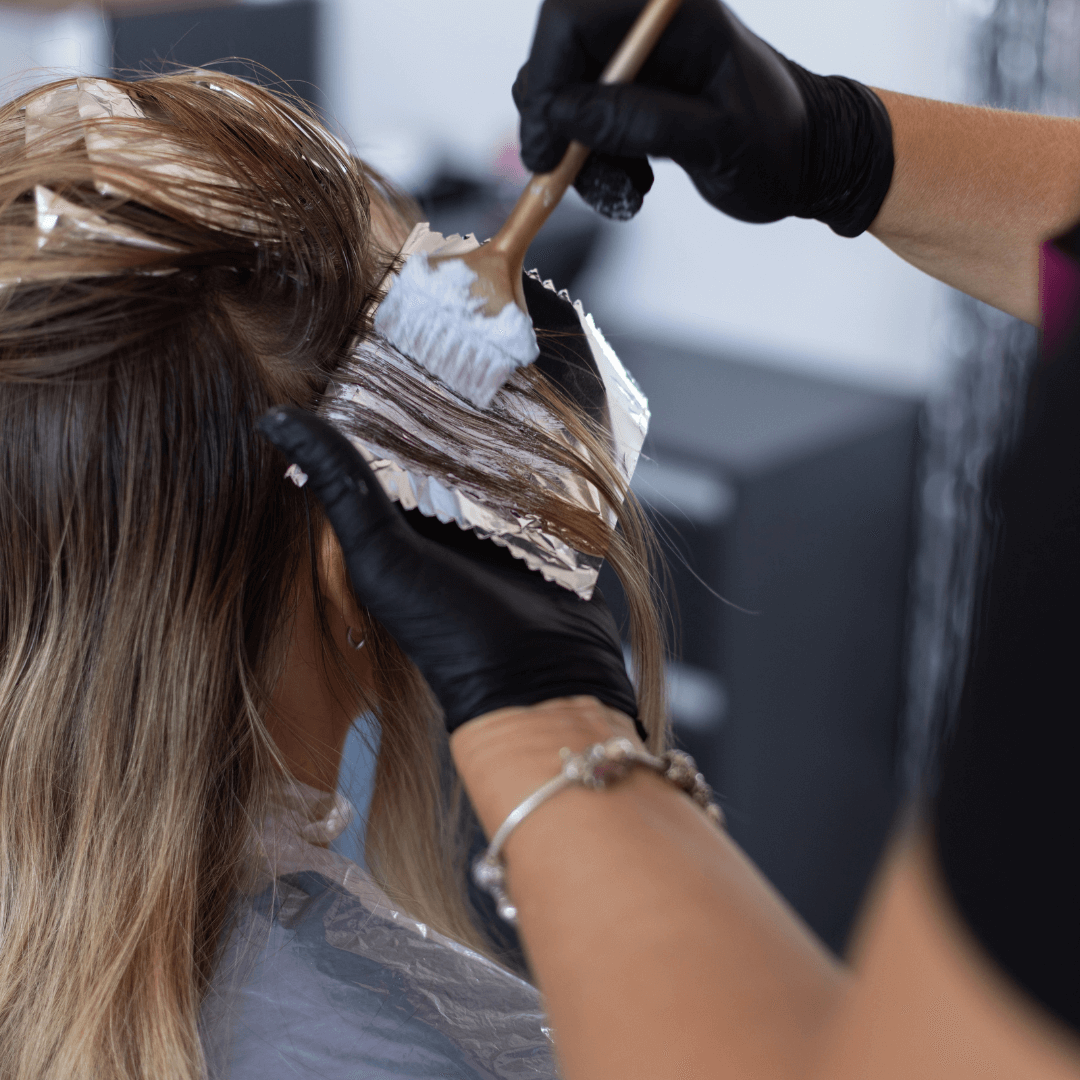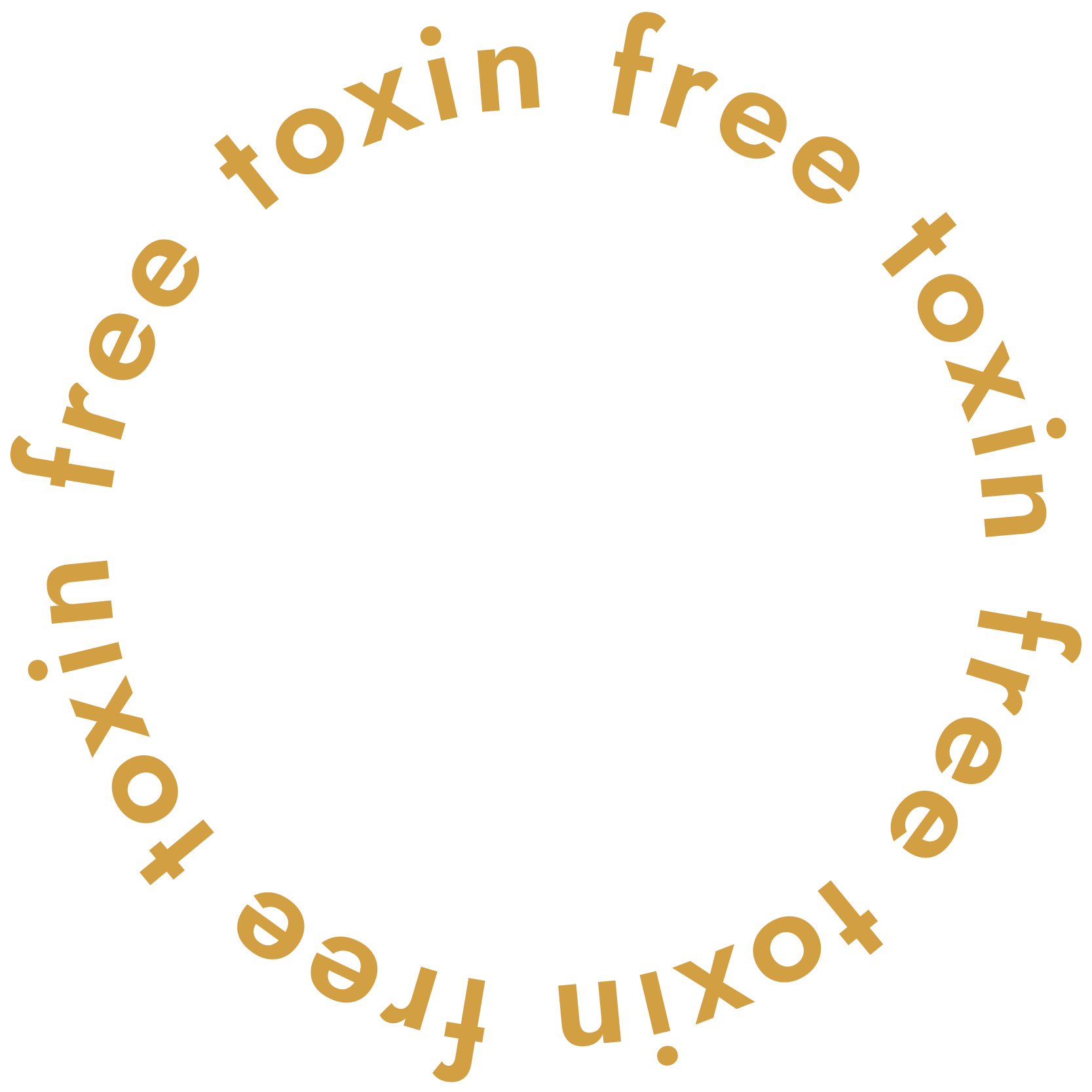In this episode, we talk about:
- The main ingredients in permanent hair dye
- Hair dye studies
- Non-toxic hair dye alternatives
I love being blonde!
I want to preface this episode by saying I love being a blonde. I have naturally dirty blonde hair. I was a towhead blonde when I was a little girl growing up, and then it slowly started to become more dirty blonde. I found it boring. So, around 18, I started dying my hair regularly and never stopped. I would dye it all over from root to tip. Then I got into the highlight era, and then the balayage was cool… More recently, I’ve been dying about twice a year. I let my roots grow out a good amount, but I’m still dying my hair pretty often.
I truly never had any intentions of giving it up. You know I’m all about a toxin-free-ish lifestyle, and embracing your ‘ish’ and hair dye was my ‘ish’. I am not about being perfect. If you listen to this episode and decide to keep dying your hair, that’s awesome. I’m going to give you some safer options if you want them or not. Take it or leave it.
I update my Toxin-Free Shopping Guide every year with new, clean products and double-check the ones I have listed to make sure nothing has changed. In the process of researching shampoo, conditioner, hair dye, hair oil, etc., I got interested because as I’m getting older, my hair is dry and brittle. It’s also starting to thin. I got interested in what I could do to grow my hair and get thicker hair.
What I found was that not only is the hair dye that I’ve been using not good for my health, but it was destroying my hair and can lead to hair thinning, hair loss, and brittle hair. I’m not doing my hair any favors by continuing to dye it.
Download the free ebook: Happy New Hair
Main Ingredients in Permanent Hair Dye
All hair dyes work mostly the same way. They have a developer that removes your existing hair color and uses an alkaline agent to open your hair shaft. It literally rips your hair shaft open. They have colorins that penetrate your hair shaft and adhere to your hair.
There are a lot of ingredients in hair dye products, but I’ll focus on the main ingredients for now.
Ammonia
I think a lot of people still believe that if they’re buying Ammonia-free hair dye, they’re buying something better for themselves and their hair. Ammonia was one of the main ingredients that were used for a long time in hair care, and it still is. There’s still a lot of hair care out there using ammonia. But brands are marketing themselves as ammonia-free and ‘more natural,’ but that’s a bunch of bullshit.
The problem with ammonia is it damages your cuticle. It takes and completely gets rid of moisture. It causes frizzy, dry, and brittle hair. It also destroys an amino acid called tyrosine in your hair. Tyrosine regulates the production of your hair pigment, which is what holds onto your new or natural color. When tyrosine is destroyed, your hair’s ability to hold any color is compromised. Dye won’t work over time because you keep using ammonia in your hair. You’re basically stripping your hair completely of all moisture, and you’re destroying it.
So they have to make up for it. They have to put other things in their products to coat your hair – silicones and things that cover the hair shaft to make it feel and look smooth so they can hide the fact that they destroyed your strands. But that will fade over time, and you’ll start to see in between your dyes that your hair will start to look less and less shiny, dull, and brittle. That’s because of the ammonia.
Ethanolamine (EA)
Brands claiming to be ammonia-free are using ethanolamine (EA) instead. If it says ammonia-free, there’s a 95% chance this is what they’re using instead. EA is extremely corrosive to your hair. According to studies, it can be up to 85% more damaging than ammonia and cause hair loss. It is also a risk factor for birth defects.
In a study published in 2005, they found that in people who used hair dye with this ingredient in it the month before pregnancy or during pregnancy, there was almost a 60% increase in neuroblastoma in the newborns they gave birth to. Neuroblastoma is a cancer that starts in the nerve cells.
There was another study that showed a threefold increase in the risk of neuroblastoma among children and mothers who use hair dye during pregnancy. Other animal studies show an increased risk of birth defects from this ingredient. If something can cause neuroblastoma in children while we’re pregnant, what else is it doing to your body?
Resorcinol
Another common ingredient in hair dye is called resorcinol, and it can cause problems in high amounts. The use of this ingredient has been shown to cause disruptions in the central nervous system and thyroid function in high doses and repeated exposures. If you’re somebody who already has a thyroid issue, you might want to avoid this ingredient.
That’s bad, but let’s talk about your hair. Resorcinol is an acute irritant and skin sensitizer. Acute irritants and skin sensitizers mean that the more you are exposed to this chemical and it sensitizes your skin, the more likely you will have an allergic reaction to it. You could be using this ingredient and dyeing your hair for many years, and then, all of a sudden, your body has an allergic reaction to it because you’ve been sensitized all of that time.
Some common reactions people have to this ingredient are hair loss, hives, contact dermatitis (really bad scalp eczema), and even respiratory distress. It’s a huge issue. When you dye your hair a lot like me over the years, you’re like, “I’m fine. Nothing’s ever going to happen, and I’ve never reacted. I’ve never lost any hair.” But it happens all the time. Every time you dye your hair, you’re risking that this will be the time your body will rebel and have a reaction.
Skin Sensitizers
This isn’t the only sensitizer found in hair dye. 1,4-phenylenediamine (PPD) and 1,4-toluenediamine (PTD) are used to bind the color to the hair permanently. A lot of people believe this is carcinogenic, although there’s conflicting information out there. But they are extreme skin sensitizers. So again, you have multiple ingredients in your hair dye that can eventually lead to this reaction.
Side note: There are henna tattoo formulations with PPD skin sensitizer in them. If you’ve had a henna tattoo in the past that has PPD in it and you continue to dye your hair, you’re more likely to have that skin-sensitizing allergic reaction. Your body recognizes that chemical from when you had the tattoo.
Here’s what clinched it for me: scientists at the National Institute of Health found that women who use permanent hair dye and chemical straighteners have a higher risk of developing breast cancer than women who don’t use the products. That risk increases with more frequent use.
Hair Dye Studies
In another study looking at over 46,000 women, women who regularly used permanent hair dye in the year before enrolling in the study were nine times more likely than women who didn’t dye their hair to develop breast cancer.
Here’s the scary thing: African-American women using permanent hair dyes every eight weeks or more were associated with a 60% risk of breast cancer as compared with the nine that they found in Caucasian women. However, that research found no increase in breast cancer risk for semi-permanent or temporary hair dye.
There’s also a link to hair straightening products. Overall, women have about a 1.6% chance of developing uterine cancer in their lives, but frequent users of hair straighteners have a threefold increased risk.
Non-Toxic Hair Dye Alternatives
After seeing the research and studies, I did some soul-searching and decided I was done with the hair dye. I don’t think I need it. I think it’s time to embrace my natural hair and grow it out. I’m going to spend the next year focused on quality hair care. I’m spraying my hair with rosemary, cedarwood, and lavender essential oils, and water. I’m doing all the things for hair growth. I’ve got my collagen. I’m just done, and I’m going to let it go and embrace the all-natural.
If you’re not quite ready to quit, there are some things you can do to reduce your risk without giving it up completely.
Semi-Permanent Color
The first thing is to switch to a semi-permanent hair color. This can work best for people who are trying to cover up grays but want to stay their natural color. You should have less than 50% of your hair that’s gray. This is also really good for people who are not that far off from their natural hair color. Using semi-permanent or henna-based dyes are cleaner options.
But you won’t be able to lighten your hair with it. For that to work, you need a developer or something to remove the color from your hair and adhere to a new color. The way semi-permanent colors work is it coats the top of your hair.
Recommended Non-Toxic Hair Dye Brands
If you’re somebody who loves your natural color but you’re struggling with grays, I highly recommend the company Hairprint. Their semi-permanent dyes are very specific to people who want to cover grays. They also have some of the cleanest hair care options out there.
Indus Valley is another great brand. Radico is a super clean henna-based product. They test for all kinds of contamination. Those are two henna-based products and companies that create semi-permanent non-toxic hair dyes that are fantastic.
Goldwell (specifically the line Elumen) makes a demi-permanent dye. It acts more like a permanent hair dye, but again, you can’t cover up more than 50% gray. You can go slightly outside of your natural color, but it lasts way longer.
If you want a permanent color, Daniel Field makes a line called watercolor, and they use sodium percarbonate instead of ammonia. If I were trying to avoid the worst ingredients in a permanent hair dye, that is the non-toxic hair dye I would choose. It also has the least damaging hair ingredients because it doesn’t have those two ingredients we talked about that are bad for your hair. That doesn’t mean it’s free of toxins. It’s just the safest out there that I have found.
Reduce Your Risk
The goal is to reduce your risk. There are toxins everywhere. Don’t worry about the things you can’t control outside your home, but you can control the things inside your home. For me, hair dye is one of those things I have a choice and control over, and so do you. You can decide to continue dyeing your hair, pick a safer option, or quit. Whatever it is you choose, my goal is to make sure you’re informed, and you’re making educated choices for yourself. You can find these safer, cleaner hair care options in my toxin-free shopping guide.
If you enjoyed this week’s episode, please:
- Leave a positive review or rating wherever you listen
- Shop toxin free products on my Toxin Free Shopping Guide
- Download your free 25 Toxins to Avoid
- Post a screenshot, share what you loved, and tag me on Instagram @wendy_toxinfreeish
- Want to ask me a question to get answered on the podcast? Leave me a voice message here.
Related Episodes
Episode 25: Stop Obsessing: Navigating a Toxin-Free Lifestyle with Balance
Episode 26: Detox Your Makeup: My Truly Clean Cosmetics Must-Haves
Episode 31: Does Toxin-Free Nail Polish Exist? Understanding the Ingredients in Your Nail Polish
Episode 79: Creating a Toxin-Free Home: Practical Tips for Families Resistant to Change


+ show Comments
- Hide Comments